The Thermaltake Toughpower 1000 Watt Power Supply is a modular enthusiast power supply. Capable of driving Quad SLI or Crossfire. It offers extremely tight voltage regulation.
INTRODUCTION
Power supplies have moved from the ugly box in the computer that no one paid any attention to, to the heart and soul of modern enthusiast systems. There are a lot of power supplies out there marketed as high-end enthusiast power supplies and are little more than cheap and not worth using in nice looking housings.
So how do you pick from the vast selection of Power Supplies out there without getting a fancy housing and rotten guts? In todays market you have to know your Power Supplies, the OEM manufacturer behind them if they use an OEM, and rely on past performance, word of mouth, and testing done on the PSU.
Today at Bjorn3D we have a Thermaltake Toughpower 1000 Watt Cable Management (modular) power supply to test. Given Thermaltake’s past performance in the power supply area and their OEM Channel Well Technologies who manufactures this line for them, we should have a winner on our hands.
Stick around and find out if the Thermaltake Toughpower 1000 Watt Modular lives up to what we’ve come to expect from THermaltake’s enthusiast line of power supplies.

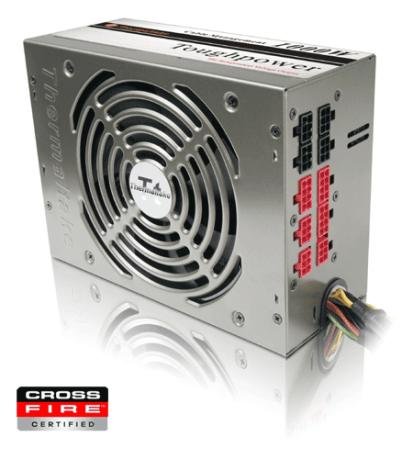
About Thermaltake
The Company
We live in a world where most things seem to move at the speed of light. At Thermaltake, we feel the same way and that is exactly how Thermaltake conducts itself to deliver innovative, reliable and customer-centric solutions to the worldwide market.
Since the beginning of Thermaltake in 1999, it has been at the forefront of creating new and exciting products at a time where most computer users were provided little to no choices for components that may seem irrelevant, but in reality crucial to the performance of a PC.
Thermaltake Server Series solutions, with years of thermal experience and industry leadership, sets its goal on reforming total thermal management in server segment by formulating the perfect mixture of versatility, efficiency and thermal management with each respective server product category: Rackmount Chassis, Server Fixed & Redundant Power Supply and Server CPU Cooling Management Solutions.
With its comprehensive line of products available, it enables Thermaltake’s core customers to enjoy a one-stop-shop experience, reduce product design-in evaluation period and most important of all, flawless integration process. Each of Thermaltake’s strengths enables its customer to focus on their core business while taking advantage of the skills and efficiency of a single thermal management solution partner.
Values & Principles
– While still a relatively young company, established in 1999, Thermaltake is built on unwavering will and dedication to address issues and innovate at the same time for computer enthusiasts and corporate users worldwide .
– With strong support of Research & Development team standing behind the brand, Thermaltake is committed to never-follow but always-lead.
– In past decades, the industrial and technological advancements in different fields have shaped the world we live in today and have also made a big impact on the environment. Thermaltake takes great measures to ensure the product that we produce relieve these impacts by being first to act on 80 PLUS® specification for computer power supply that greatly reduces the amount of electricity that a computer consumes.
– Always striving to be the best, we continuously benchmark our performance against the very best internally and externally.
– Customers are our greatest asset and Thermaltake does not take that for granted. That is why Thermaltake is the industry leading in customer service and customer support with around-the-clock automated product return service.
FEATURES
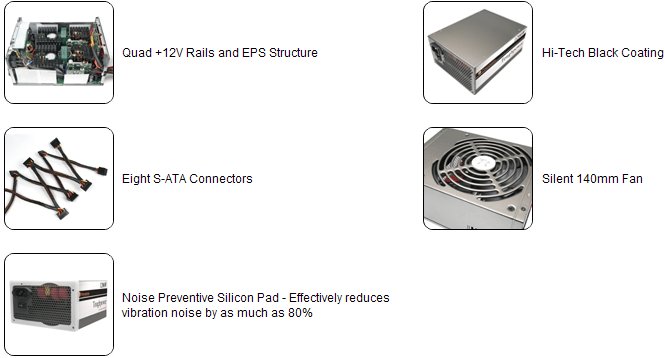

Connectors

They’re plenty of connectors on the Thermaltake Toughpower 1000 Watt Modular PSU and I know a lot of you are wondering how many of those PCI-E Connectors can I actually use so let me jump the gun a little and show you.

Thermaltake didn’t kid around with the Toughpower 1000 Watt Modular, you can drive Triple SLI or Crossfire with dual connector GPU’s. Quad SLI or Crossfire on single connector cards. With the current cost of the nVidia 9600 and the new nVidia release this week I can see prices dropping even farther and people scrambling for power supplies that can drive Triple and Quad SLI. Given the high prices of the GTX line Quad 9600s are looking pretty good and we are seeing more Triple and Quad GPUs in systems every day.
”Oh no, I need six 6 pin connectors for my triple SLI I’m Jacked.”
No, you’re not Jacked. Thermaltake has you covered on the needing six 6 pin connector issue.
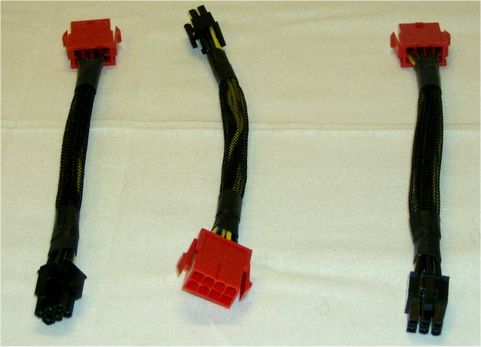
They thoughtfully included three 8 to 6 pin adapters so no matter the setup on your GPU’s you can run some triple SLI or Crossfire goodness.
Now that we’ve seen some of the features of the Thermaltake Toughpower 1k modular lets take a look at how the voltages break down.
SPECIFICATIONS
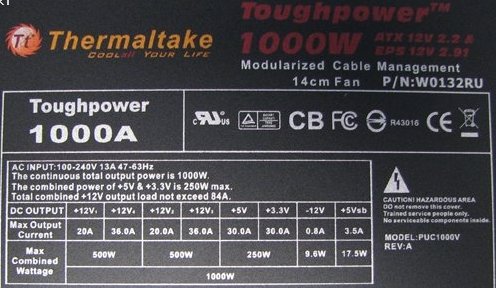
For those that have older eyes and no appreciation of my limited photographic skills here’s a graphic of the voltage break down.

If you’re like me you’d like a little clearer breakdown of the voltages that’s a little easier to read, so we came up with this graphic for you.
|
Thermaltake Toughpower 1000 Watt PSU |
||
| AC Input Rating | 100 – 230VAC | |
| Input Current | 13 Amp | |
| Frequency | 47Hz – 63Hz | |
| Output Voltage | Max Load | Max Output |
| +3.3V | 30 Amps | 250W |
| +5V | 30 Amps | |
| +12V1 | 22 Amps | 1000W |
| +12V2 | 22 Amps | |
| +12V3 | 36 Amps | |
| +12V4 | 36 Amps | |
| -12V | 0.8 Amps | 27.1W |
| +5Vsb | 3.0 Amps | |
| Total Power | 1000W | |
| Efficiency | 80 Plus (87% peak) | |
| Dimensions | 200mm(W) x 160mm(L) x 86mm(H) | |
As a few of you might have figured out I like to get down deep into the features and specifications on a product and if I know about it I’m probably going to blab on it a little.
Operating Environment
- Operating Temperature…………10-50C
- Storage Temperature………….-20-70C
- Operating Humidity………………20-90% (non-condensing)
- Storage Humidity………………....5-95% (non-condensing)
It’s ability to operate up to 50C or 122° Fahrenheit is an amazing top end operating temperature and makes the Toughpower an attractive option for those living in hotter environments or with out air conditioning. When they say Toughpower they mean Tough Power!
The 20-90% humidity non-condensing probably means it’s not a good idea to play with the Toughpower in the rain. Actually it means it’s not a good idea in high humidity situations to take it from a cool environment to a hot humid environment and use it before the temperature of the PSU and the environment equalize. Much like a glass of Ice Tea developing drops of water on the side of the glass; water can condense in that situation and if moving to a high humidity environment it’s a good idea to let the computer set overnight to prevent condensation.
Protection Circuits
- Over Voltage Protection
- +3.3v Trips @ 4.5v
- +5v Trips @ 7.0v
- +12v Trips @ 15.6v
- Over Current Protection
- +3.3v range @ 33-50A
- +5v range @ 33-50A
- +12v1 and +12v2 range @ 22-35A
- +12v3 and +12v4 range @ 39-55A
- Under Volt Protection
- +3.3v trip point @ 2.0v
- +5v trip point @ 3.3v
- Short Circuit Protection
- All Output to Ground
At this point you probably know more about the Thermaltake Toughpower than you ever thought you wanted to. Understanding a power supply also means understanding the finer points of Rails and Specifications, so I throw in a section I like to call “What about them Rails?”
WHAT ABOUT THEM RAILS?
We have all, no doubt, been told that when purchasing a power supply that the number to look for is the amps on the 12V rail. What are each of the different rails for though, and why is the 12V rail typically the most important? Why the heck are they called rails? Let’s take at look at each and see.
-12V – This rail is pretty much obsolete now and is only kept on to provide backward compatibility with older hardware. Some older types of serial port circuits required both -12V and +12V voltages, but since almost no one except industrial users use serial ports anymore you as a typical home user can pretty much disregard this rail.
-5V – Again this is another obsolete rail, the -5V was used for old school floppy controllers and some ISA bus cards. Again, no need for the typical home user to worry about this rail.
0V – Though not listed on any manufacturer spec sheet, every power supply has a 0V ground line. The ground signal is used to complete circuits with other voltages and provide a plane of reference against which other voltages are measured.
+3.3V – Finally we are starting to get into something useful! The +3.3V rail was introduced with the ATX form factor in order to power second generation Pentium chips. Previously the CPU was powered by the +5V rail (along with the system memory and everything else on the motherboard), but a reduced voltage was needed in order to reduce power consumption as the chips got faster. Until just recently, the +3.3V was used to exclusively power the CPU as well as some types of system memory, AGP video cards and other circuits.
+ 5V – As mentioned above, the +5V used to run the motherboard, CPU and the majority of other system components on older pre ATX based systems. On newer systems, many of the components have migrated to either the +3.3V or +12V rails, but the motherboard and many of its onboard components still use the +5V rail so it is of importance to the typical home user.
+5V SB – The +5V Standby or “Soft Power” signal carries the same output level as the +5V rail but is independent and is always on, even when the computer is turned off. This rail allows for two things. First, it allows the motherboard to control the power supply when it is off by enabling features such as wakeup from sleep mode, or wake on LAN technology to function. It also is what allows Windows to turn your computer off automatically on shutdown as opposed to previous AT supplies where you had to bend over and push the button. Every standard ATX power supply on the market will include this rail.
+ 12V – The +12V, also known as the mother of all rails, is now used to power the most demanding components in your system including the CPU, hard drives, cooling fans, and graphics cards. Historically the +12V rail was used only to power drives and cooling fans. With the introduction of the 4-pin CPU plug on P4 motherboards and then eventually AMD based motherboards, in order to supply newer power hungry CPUs, the +12V rail suddenly started to grow in importance. Today, dual core based motherboard require an 8-pin +12V connector to supply their power needs. High end GPU cards have also jumped on the +12V rail, which has required PSU makers to adapt. Where previously there was only a single +12V rail, there are now two or more, each designated to power specific devices in order to ensure that nothing is underpowered.
Now as to why they are called rails, the best explanation that I can find is that the term comes from the wacky world of electronics and it refers to a long metal bar or strip that is used to provide a particular voltage level. Perhaps someone with a deeper understanding of all things electrical could let me know whether or not that is true.
ATX 12V V2.2 Standard
ATX 2.20
2.20 is where we currently stand as of March 2005. It was released the same month as the short lived 2.1 revision which is why you won’t see any units bearing that standard. The 2.20 again increased the efficiency requirements which now stand at a minimum of 65% or greater and a recommended level of 75% or greater. The +5VSB rail has also been increased to 2.5A
In short any power supply post 2.0 will do the job for you. The biggest advantage of purchasing a latter standard model would seem to be the increase in efficiency rating.
EPS12v Standard
The EPS12V specification is one of those standards that most people have heard about, but very few know what it actually does. The EPS spec itself is defined in the Intel Server System Infrastructure (SSI) spec and is currently at v2.1.
The EPS12V spec dictates that Power Supply units must have a 24pin 12V connector as well as one additional 8-pin 12V connector. If a PSU is noted as EPS12V compliant you can be assured that it will have all the connections you need to power your new dual core based system, however it should also be noted that units do not necessarily have to meet EPS12V spec to include an 8-pin 12V connector.
My “What About Them Rails?” section needs a little updating but it’ll provide enough current information that it’s still useful for the novice hunting for a viable PSU for that gaming monster their building.
Enough of the boring stuff lets get on to some Packaging and Bundled Accessories!
PACKAGING AND BUNDLE


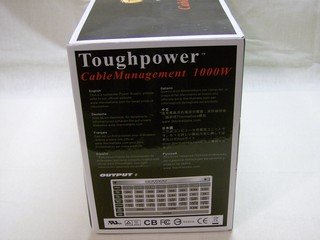
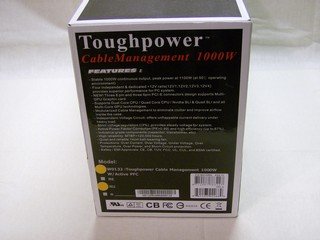
The Thermaltake Toughpower 1k Cable Management power supply comes in an attractive box constructed of heavy duty cardboard. There’s a lot of specifications, voltage regulation specifications, and pictures wrapping the box.
There’s plenty of information about the power supply and voltages supplied, enough for the informed consumer to make an intelligent decision about the purchase of the PSU.
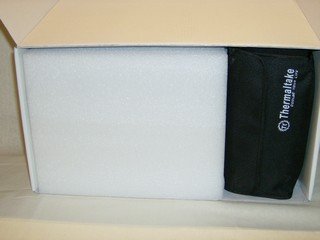
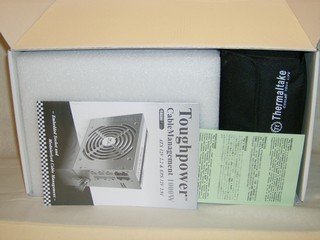
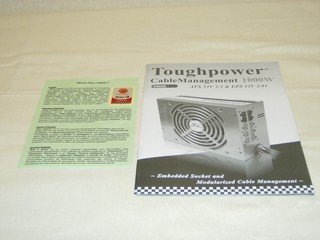
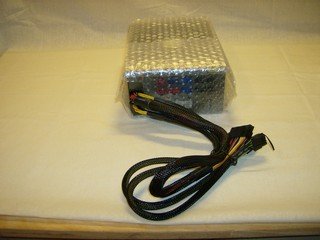
Opening the box you’ll find the Toughpower cocooned in Styrofoam with a manual and case badge on top. You’ll also find a bag of cables, a boxed power cord and the Toughpower itself further wrapped in a bubble wrap bag to protect it from scratches.
The Bundle

Inside the box you’ll see the manual, power cord box, a bag of cables, the case badge, the Toughpower itself, and a silicone gasket that reduces noise by as much as 80%. Of course you can’t really get a good look at stuff all bagged up so lets take a little closer look at the bundle before we move on.
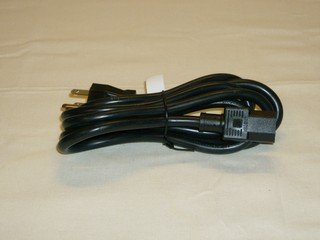
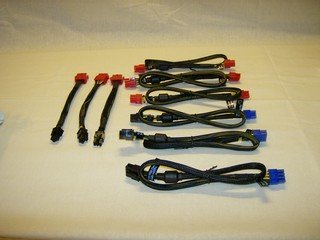


There’s a peek at the heavy duty power cord, Six PCI-E connectors with the 3 included 8 to 6 pin adapters, the 8 molex and 2 floppy connectors, and the 8 sata connectors. Now let me take my shoes off so I can count up the possible connections, 24 possible connections total. That is if your hard core and want 2 floppies and triple Sli, a basket of fans, and 16 drives of assorted types. You’ll probably have to spend some serious scratch to get all that equipment together.
I don’t know about you but I’m ready to take a closer look at the Toughpower itself.
IMAGES & IMPRESSIONS

The Toughpower 1k modular isn’t one of those froufrou looking power supplies that depend more on flash than performance to sell it. It’s not ugly by any means, but it’s got more of a minimalist look to it than any thing else. I found myself thinking that with Thermaltake’s propensity to add a little dash of flash here and there it would have been easy for them to go overboard and stick a bunch of LEDs and bells and whistles to pretty it up. As it sits though it just screams “Power and Plenty of it.”
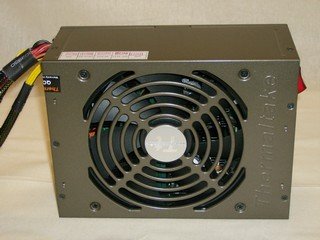
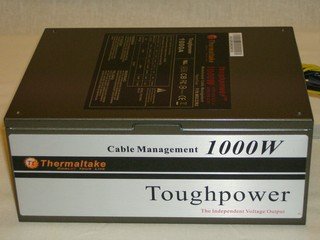
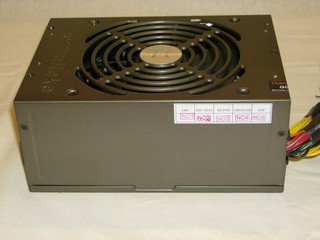
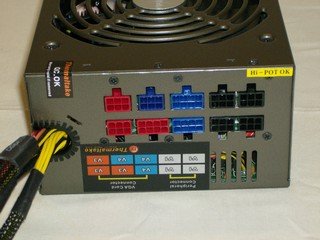
There you can get a look at the PSU from all sides. Notice the Hi-Tech black coating, it’s kind of strange because in high lighting it looks silver, in medium lighting it looks brown, and in lower and cold cathode lighting it takes on a distinct black tone. The fan shots show the 140mm ultra silent fan that’s actually a Yate Loon re-stamped to Thermaltake TT-1425B. The actual model Yate Loon ball bearing fan is D14BH-12. Yate Loon is a quality fan manufacturer that manufactures high quality fans for a lot of companies. I use a couple of sets on my custom water loop radiators and even at 83 CFM full speed they’re barely audible outside the case. The 140mm on the Toughpower was inaudible inside the case during testing, and provides really good air flow to keep it cool.
If you’ll notice the PCI-E connectors for a second there’s 2 blue 8 pin and 1 red 8 pin, that got me to thinking some. Earlier I had noticed a little unusual quirk in the +12v rails.

See how they have the +12v rails listed? The +12v1 and +12v4 are together, and one is 20A and the other 36A, then +12v2 and +12v3 are listed with the same voltages. Then combined with the 8 pin PCI-E being Red and Blue it got my curiosity way up. I’m having the urge to get a screw driver out and see what Thermaltake has done inside this beast because I’m smelling dual power supply in one chassis which would explain something I saw on the voltage panel as well.

See how they have the +12v1 and 4 and the +12v2 and 3 are listed? Both listing 500w but boxed separately, if I were a betting man I’d throw my better half’s best thong in the pot that there’s two power supplies in one chassis here. Not that that’s a bad thing as long as they’ve taken care of the inefficiency problems that can incur.
INSIDE THE TOUGHPOWER 1K MODULAR
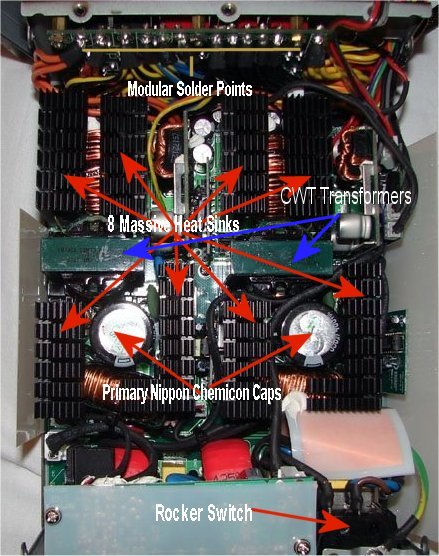
You can see the two large primary capacitors made by Nippon Chemicon. Thermaltake is using high quality Japanese capacitors in there! Then the Modular solder points up at the top, rocker switch at the bottom, and all the solder points were solidly soldered. Then there in the center you can see the Channelwell Technologies transformers and the 8 massive heat sinks. It’s no wonder the Toughpower is a heavy unit. The silk screening on the PCB also tells me this is a Channelwell built PSU.
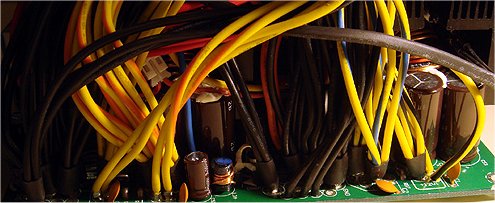
See how the power leads are in two distinct clumps there? Then look at the symmetrical design in the previous picture; there’s technically two 500 watt PSUs in the Toughpower 1k side by side. Like I said before, that’s not a bad thing as long as efficiency is maintained and the Toughpower 1k runs between 80% and 87% peak efficiency so that’s not an issue. Thermaltake has a new Toughpower 1k just out and now I’m going to have to dig into that one and see what it looks like in there (if they’ll send a sample).
Reflecting on it for a second I thought I’d better tell you that opening your power supply isn’t really recommended as it will void your warranty and if you don’t know what your doing there’s enough power stored in a freshly unplugged PSU to stop your heart and give you a really sweet “Mad Science” hairdo.
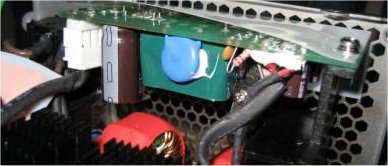
There’s a peek at the power regulation panel tucked up under the flap where it’s tucked away hidden in the other shots.
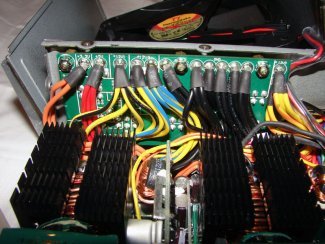
There’s a better look at the well soldered modular power connection solder points. That’s some pretty good solder work there. Pretty impressive components in the Toughpower.
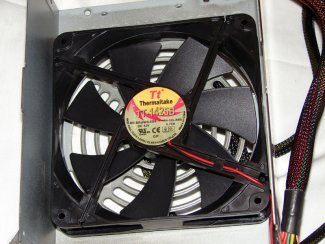
Then there’s the Thermaltake Thermaltake TT-1425B fan, which is actually a ball bearing Yate Loon D14BH-12.
In all I’m seriously impressed with the Thermaltake Toughpower 1k components and if Thermaltake and Channelwell have the design right I’m pretty sure were going to be seeing less than 3% variance on any rail load or idle. Personally I’m betting 1 ½% or less and I’m usually pretty good at guessing from interior components.
Onward and forward to Testing And Methodology
TESTING & METHODOLOGY
When it comes to power supplies, any power supply, what you’re really looking for is good clean voltage and plenty of it. Current standards are 5% variance on any rail maximum, which is a little more lax than my personal standard of 3% max everywhere but the +5vSB (+5v stand by) which is always on even when the power supply and computer are off. On the +5vSB it’s not unusual to see 5% and since it’s only for wake on Lan or by device feature it’s not a big deal.
Like a lot of you enthusiasts out there, my PC is an ongoing work of art that I have a lot of cash invested in. If a PSU won’t hold to 2 or 3% load/idle no matter what I do to it, I won’t use it or recommend it.
Testing Equipment
| Thermaltake Toughpower 1K Testing Equipment |
|
| Multimeter | Craftsman |
| LCD Voltage Tester | Coolmax Digital LCD PSU Tester |
| Thermometer | Micro Temp Digital Infrared Thermometer |
| Connectors | 24 Pin Motherboard Connector Splitter |
| Wall Voltage | Kill A Watt Voltage Measurement Device |
I do things a little different than a lot of testers with Power Supplies. I take readings with a Craftsman multimeter, then I use a 24 pin Motherboard Connector splitter to connect to the PSU and the Mobo leaving one connector open for a Digital LCD PSU tester to connect to during load and idle tests. This gives the advantage of measuring all the same voltages you can test with a multimeter plus I get the -12v which can’t be tested with a multimeter, and the +5vSB. Then I also use an IR thermometer to record the input air temperature and exhaust temperature because the input/output temps can tell you how hard the PSU is working to provide the voltage.
Test Rig
| Test Rig “Quadzilla” |
|
| Case Type | Thermaltake Armor |
| CPU | Intel Q6600 @ 3.6 Voltage 1.3675 vcore |
| Motherboard | Asus P5KC |
| Ram | Mushkin DDR3 12800 @ 1600Mhz |
| CPU Cooler | Swiftech MCP350 Pump Swiftech Apogee GT CPU Water Block Swiftech Micro Res Swiftech MCR320 360mm Radiator 3 Yate Loon 120mm 12v Fans 83CFM |
| Hard Drives | WD 250 Gig Sata 2 Two Maxtor 160 Gig Sata2 |
| Optical | Sony DVD R/W |
| GPU | XFX 8800 GT Alpha Dog 675/950 OC |
| Case Fans | Two 120mm Thermaltake Front/Rear Push/Pull 250mm Side fan 90mm Rear Exhaust 90mm Top Exhaus |
| Docking Stations | Tagan IB290 W/Deskstar 2 1/2 Inch 80 Gig Sata 2 Tagan IB390 W/Maxtor 160 Gig Sata 2 Thermaltake BlackX USB W/Seagate 80 Gig Sata 2 |
| Testing PSUs | Seventeam Hurricane 1200 Watt Thermaltake Toughpower 1000 Watt Modular |
| Legacy | Floppy Drive |
| Mouse | Razer Lachesis |
| Keyboard | Razer Lycosa |
| Gaming Headset | Razer Piranha |
| Speakers | Logitec Dolby 5.1 |
| Any Attempt Copy This System Configuration May Lead to Bankrupcy | |
The Thermaltake Toughpower 1000 Watt pushes a lot of power and I really don’t even know anyone that has a beefy enough rig to drive it fully. I beefed up Quadzilla with some docking stations for a total of 6 hard drives. I’ll be spinning up all six drives with various tools, music, Hard Drive diagnostics, and benchmarks, the primary drive will be left running two instances of Orthos Driving all 4 cores to the max and stressing the memory. 3DMarks2006 will be driving the GPU, 10 fans of various sizes spinning full speed (including the Duo Orb on the 8800 gt), Lighted Keyboard and Mouse shining in all their glory, and the pump pumping along. It’s not going to fully load the Testing Power Supplies but there’ll be enough voltage to get good readings at Idle and Load. In the mean time I’ve cloned the boot drive and I’ll be chanting “No BSOD No BSOD with all that running.”
I’ll be measuring the voltages coming off the Tagan and Thermaltake on every rail 2 different ways, Multimeter and Digital LCD PSU Tester. Each rail will be measured 3 times on both PSU using both methods. Then each set of results will be averaged into a conglomerate number (IE: The 6 readings will be averaged to give me a result for each rail). Then during every test I’ll be taking the Intake air Temperature and Exhaust temperature. That should yield some pretty accurate results.
Lets move on to some Testing Results.
TESTING RESULTS
Power Test Results
The current ATX 2.2 specifications allow for the following variation in voltage outputs:
- 3.3 Volt Rail: 3.135V – 3.465V
- 5 Volt Rail: 4.75V – 5,25V
- 12 Volt Rail: 11.4V – 12.6V
|
Power Output Results(V) |
||||||
| Power Rail | Thermaltake Toughpower 1000 Watt |
Seventeam Hurricane 1200 Watt |
||||
| Idle | Load | Idle | Load | |||
| 3.3v | 3.31 | 3.33 | 3.34 | 3.34 | ||
| 5v | 5.05 | 5.06 | 5.12 | 5.11 | ||
| 12v1 | 12.07 | 12.08 | 12.21 | 12.18 | ||
| 12v2 | 12.11 | 12.10 | 12.17 | 12.19 | ||
| 12v3 | 12.12 | 12.14 | 12.21 | 12.18 | ||
| 12v4 | 12.10 | 12.04 | 12.08 | 12.07 | ||
| 5vSB | 5.01 | 5.03 | 5.12 | 5.15 | ||
| Wattage Used | Idle Power: 390Watt(± 5%) Load Power: 480Watt(± 5%) |
|||||
Power Factor Test Results
|
Power Factor Percentage |
||
| Power Supply | Idle | Load |
| Thermaltake Toughpower 1000 Watt | 96% | 97% |
| Seventeam Hurricane 1200 Watt | 95% | 95.7 |
Air Input/Output Tempreture Results
|
Air Input/Output Tempreture Results |
||
| Power Supply | Input Temp. | Output Temp. |
| Thermaltake Toughpower 1000 Watt | 23C | 34C |
| Seventeam Hurricane 1200 Watt | 23C | 37C |
| Ambient | 22C | 23C |
|
Ambient Measured Inside The Case |
||
CONCLUSION
Recently here at Bjorn3d we’ve been swamped with power supply review requests over the last few months. That means two things:
- There are a lot of new and exciting power supplies out there
- We’ve been doing some thing right with the Power supply reviews
Having said that we need to turn back to the Thermaltake Toughpower 1k Modular Cable management review at hand. It’s no infant to the market and has been around for a while. Still, it’s exciting to see a Power Supply that has survived the test of time and competition.
Measuring a Power Supply is a little different than a lot of products We have a set table of what’s acceptable and what’s not. Generally speaking, ± 5% is the listed standard on all rails but the -12v and that’s 10% as listed by the current ATX 2.2 standard. Right out of the gate Thermaltake lists the acceptable standards for their Toughpower at ± 3% which is the first time I’ve ever seen a company that lists my personal standards as their own. Then, the Toughpower lived up to the promise of no more than ± 3% and surpassed that promise by keeping voltage regulation tighter than that. Other than the voltage regulation there are factors that come into play, aesthetic value, cabling, voltage, bang for buck, and how the power supply makes you feel. The feeling that a reviewer gets must be carefully weighed and translated without bias and ignoring any flaws found in the review.
While both the Thermaltake Toughpower and the Seventeam Hurricane 1200 Watt were within acceptable limits, the Toughpower really shined. Variances from idle to load were infinitesimally small. While not totally modular like some models; the Toughpower only has the Mainboard connector and the CPU connector hard wired. Some of the “Modular” power supplies seen in the last few months have as many as seven hard wired components and barely qualify as modular. The two hard wired cables on the Toughpower are going to be used in every modern machine so I don’t see a downside, as long as they are properly protected against chassis chafe.
The noise levels during operation weren’t detectable at any time with the side of the case on. It doesn’t have a lot of bling factor but extrudes toughness and durability that instills a confidence in the end user that makes you feel like you can trust your expensive components to it. The inclusion of the silicone gasket which reduces noise by as much as 80% was a nice touch, and the 8 to 6 pin PCI-E adapters insure that no matter what your GPU is set up to handle you’ll be able to depend on the Toughpower having the right connectors to service it.
At the listed price of $299 at the time of publication we found the Toughpower to be in line with other power supplies of the same wattage yet providing as tight a voltage regulation as this reviewer has ever seen. Having kept a data base of PSU for comparison I flipped through it and the Toughpower has the tightest voltage regulation of any Power Supply I’ve ever had the pleasure of testing.
I would seriously recommend the Thermaltake Toughpower 1000 Watt Modular Cable Management to anyone needing high wattage and tight Voltage regulation to drive that massive machine (and investment) they’ve so lovingly built up.
Pros:
+ 1000 watts of clean, solid, and stable power
+ Active PFC
+ Efficiency rating > 80%
+ Triple SLI/GPU ready
+ Compact case dimensions for it’s output
+ Dual Core/Quad Core CPU ready
+ 8-pin PCI-E connectors
+ Well sleeved cables and plenty of connectors
+ Quiet operation
Cons:
– The main power connection cables are a little short
Final Score: 9.5 out of 10 and the Bjorn3D Seal of Approval.
 Bjorn3D.com Bjorn3d.com – Satisfying Your Daily Tech Cravings Since 1996
Bjorn3D.com Bjorn3d.com – Satisfying Your Daily Tech Cravings Since 1996



